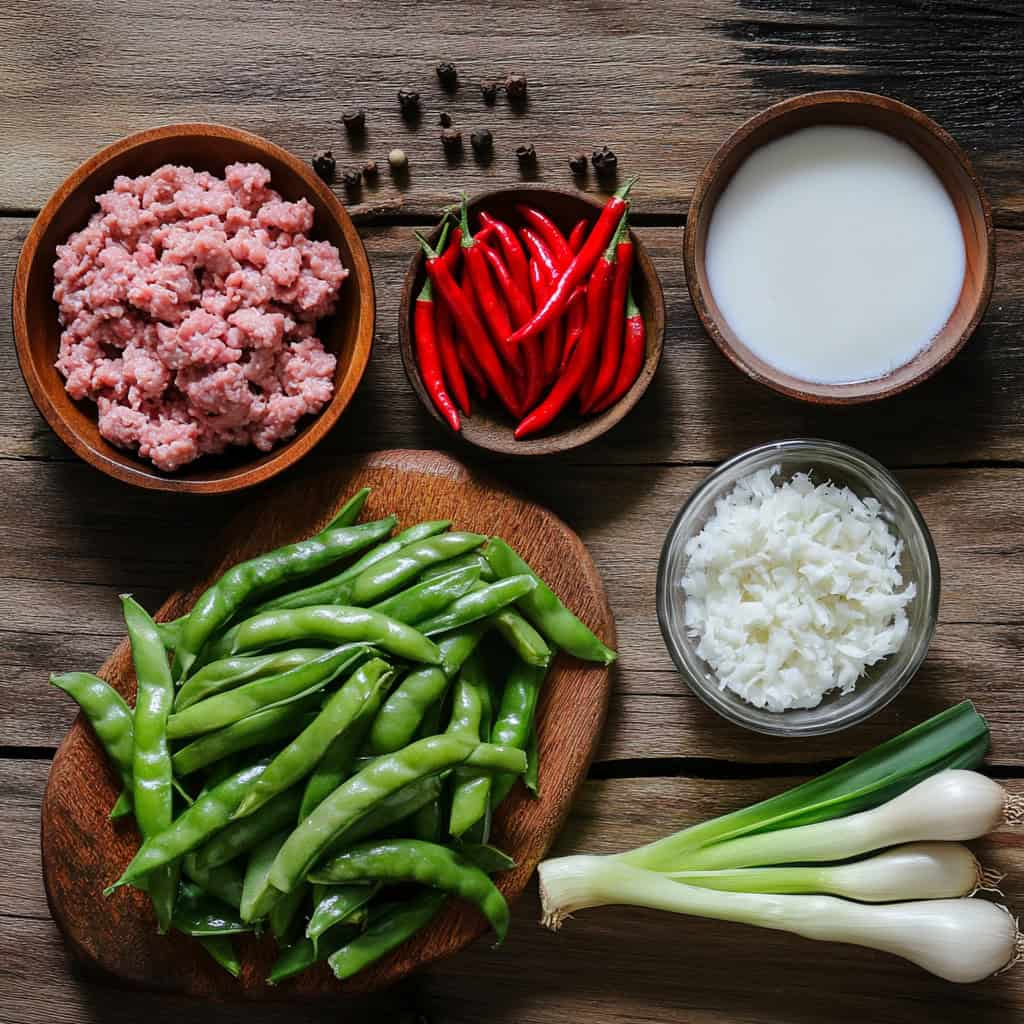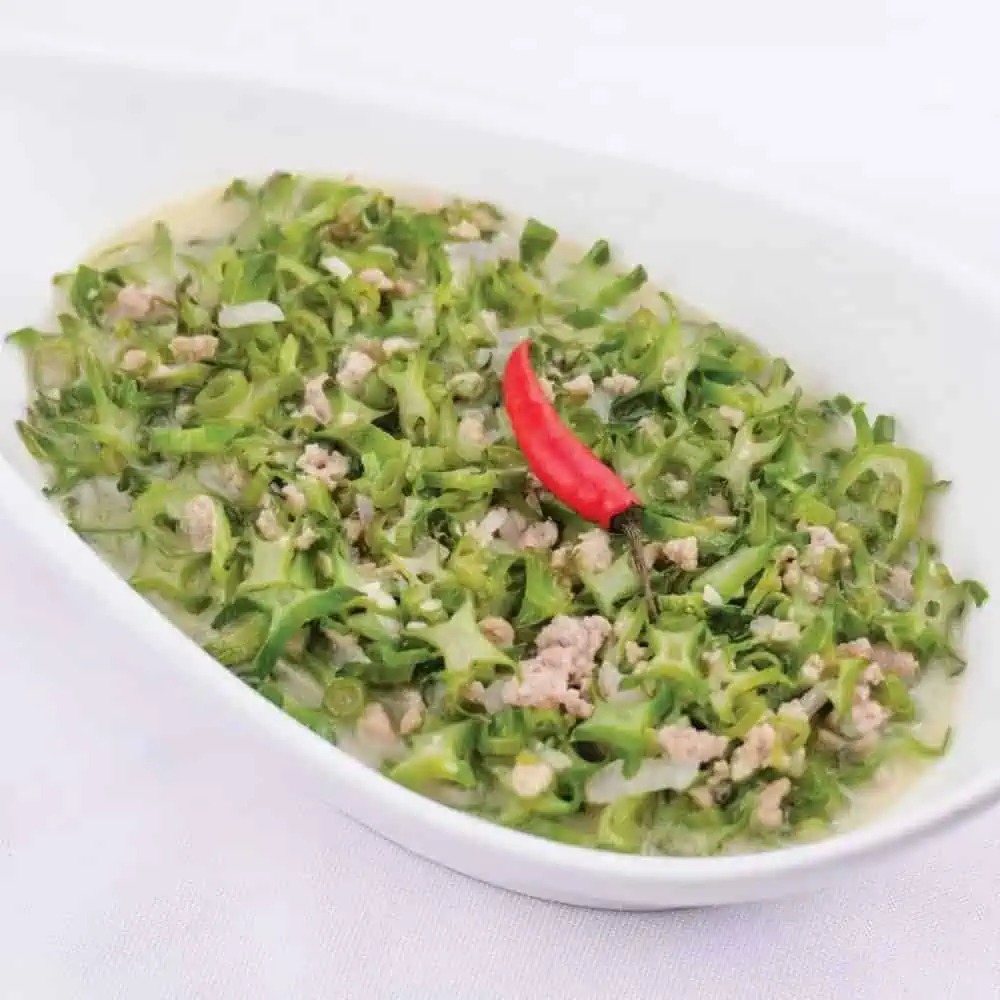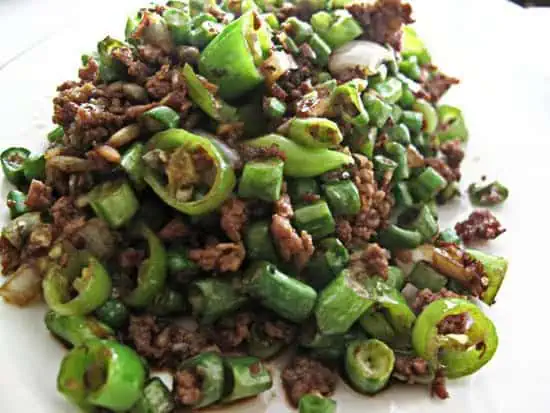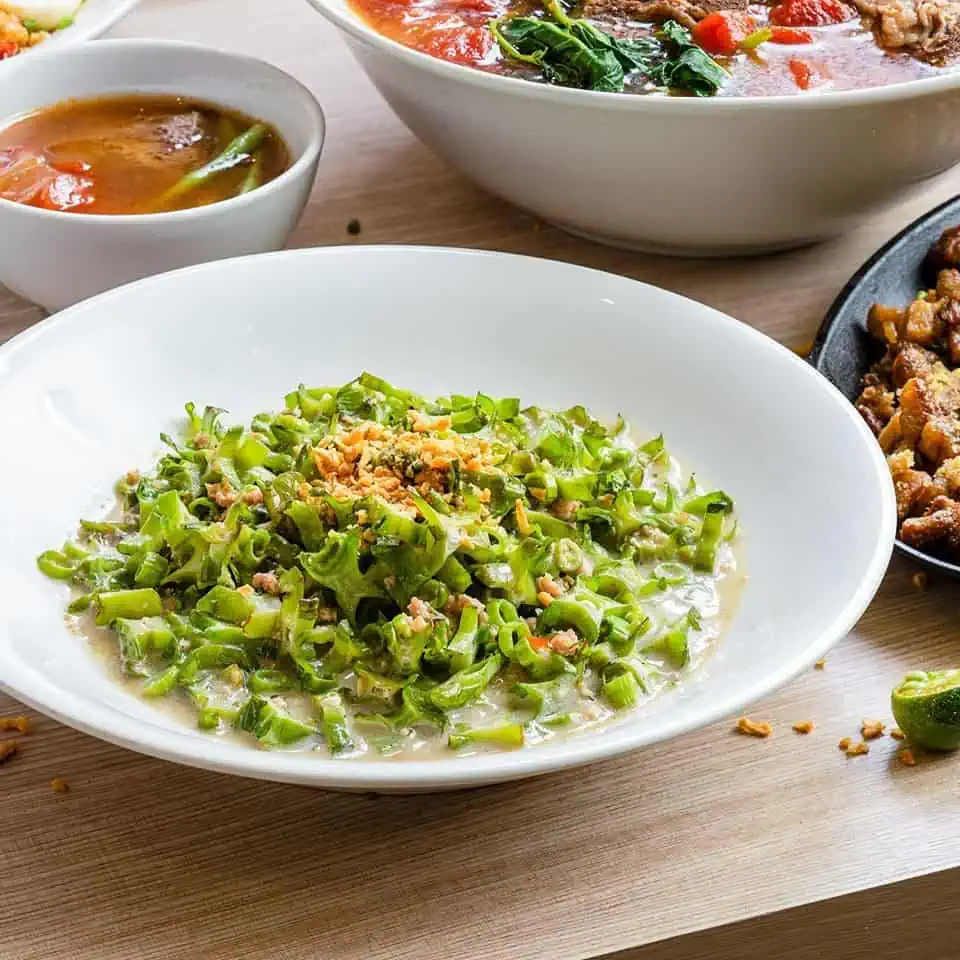The first time I tasted Gising Gising wasn't at my Lola's kitchen, but at Manam Filipino restaurant during a rainy afternoon in Manila. One spoonful of that creamy, spicy coconut stew, and I understood why it's called "wake up, wake up," it literally jolted my taste buds awake!
As a Filipino who grew up with traditional dishes, I was surprised I hadn't tried this Kapampangan favorite sooner. The way the coconut milk (gata) perfectly balanced the heat from the siling labuyo, while the ground pork and Baguio beans created this amazing texture, it was simply delicious.
After countless attempts to recreate Manam's version at home, I've finally perfected this recipe. This homemade Gising Gising recipe is a game-changer. It's simpler than you'd think, but packs all that authentic Kapampangan flavor that made me fall in love with it.
Whether you're craving that Manam restaurant experience or just want to spice up your usual ulam rotation, this authentic gising gising recipe hits all the right spots.
What is Gising Gising?
Gising Gising is a vibrant Kapampangan dish that literally translates to "Wake Up, Wake Up" - and for good reason! This explosive Filipino recipe combines ground pork, crisp green beans, and a fiery coconut milk sauce that will instantly awaken your taste buds. My first encounter with this dish at Manam Filipino restaurant in Manila was a culinary revelation - a perfect balance of creamy coconut milk, spicy chilies, and savory ground pork that captures the essence of Filipino comfort food.
Jump to:

Why You'll Love This Recipe
- Perfect Balance - The creamy coconut milk (gata) perfectly tempers the fiery chilies
- Quick & Simple - Ready in under an hour with basic ingredients
- Versatile - Easy to adjust spice levels to your preference
- Authentic - Traditional Kapampangan recipe with modern tips
- Nutrient-Rich - Packed with protein, vegetables, and healthy fats
Ingredients
Each ingredient in Gising Gising plays a crucial role in creating its iconic flavor. Ground pork provides a rich, meaty base, while green beans add a fresh, crisp texture. The coconut milk creates a creamy foundation that balances the heat of bird's eye chilies, and the bagoong (shrimp paste) introduces a deep, umami saltiness that's quintessentially Filipino.
These ingredients work together to create a dish that's simultaneously spicy, creamy, and utterly satisfying, a true representation of Kapampangan cuisine's bold flavor profile.

Main Ingredients:
- 500 g green beans (Baguio beans/sitaw), chopped into ¾-inch pieces
- 250 g ground pork
- 2 cups coconut milk (kakang gata)
- 1½ tablespoons shrimp paste (bagoong alamang)
- 3-4 bird's eye chilies (siling labuyo), finely chopped
- 3 cloves garlic, minced
- 1 medium onion, finely diced
- 2 tablespoons cooking oil
- ½ teaspoon ground black pepper
Optional Garnish:
- Chopped green onions
- Fried garlic bits
- Extra chilies
Equipment Needed
- Large Deep Pan or Kawali:
- Essential for even cooking and traditional preparation
- Ensures proper heat distribution for browning meat and simmering sauce
- Wooden Spoon or Spatula:
- Perfect for breaking up ground pork
- Prevents scratching of non-stick surfaces
- Helps in gentle stirring of coconut milk
- Sharp Knife:
- For precisely chopping green beans, garlic, onions, and chilies
- Ensures uniform cutting for even cooking
- Measuring Cups and Spoons:
- Crucial for accurate ingredient proportions
- Helps maintain the recipe's authentic flavor profile
- Cutting Board:
- Provides a stable surface for ingredient preparation
- Preferably separate boards for meat and vegetables

How To Make
- Heat oil in a deep pan over medium heat (180°C/350°F).
- Add minced garlic and cook for 1 minute until light golden brown. Be cautious not to burn.
- Add diced onions and cook 2-3 minutes until translucent.
- Introduce ground pork, breaking up any large chunks. Cook 7-8 minutes until nicely browned.
- Sprinkle black pepper, add shrimp paste, and stir well.
- Add chopped bird's eye chilies, adjusting quantity to your heat preference.
- Pour in coconut milk, reducing heat to medium-low. Simmer gently for 15-20 minutes until sauce thickens.
- Add chopped green beans, cooking 5-7 minutes until tender-crisp.
- Taste and adjust seasoning as needed.
- Garnish and serve hot with steaming white rice.

Tips from Lola's Kitchen
- Fresh is Best: Always use fresh coconut milk for maximum flavor
- Bean Perfection: Keep green beans slightly crisp - avoid overcooking
- Flavor Hack: Lightly toast bagoong before adding other ingredients
- Chili Wisdom: "Lagyan ng siling labuyo ayon sa gusto" (Add chilies to taste)
Substitutions and Alternatives
- Protein Swap:
- Ground chicken or turkey
- Shrimp or squid for seafood version
- Mushrooms and tofu for vegetarian option
- Bean Alternatives:
- String beans (sitaw)
- Bell peppers for milder heat
- Coconut Milk Substitute:
- Coconut cream powder mixed with water
- Combination of coconut cream and water
Troubleshooting
Sauce Too Watery?
- Simmer uncovered to reduce
- Add more ground pork
- Use a wider pan for faster evaporation
Too Spicy?
- Add more coconut milk
- Serve with extra rice
- Remove seeds from chilies
Coconut Milk Curdling?
- Lower heat immediately
- Stir constantly
- Use fresh, high-quality coconut milk
Storage and Reheating
- Refrigeration: Store in airtight container for up to 3 days
- Reheating:
- Gentle stovetop heating
- Add splash of coconut milk to restore creaminess
- Freezing: Not recommended due to coconut milk content

FAQ
Why is it called Gising Gising?
The name means "wake up, wake up" in Filipino, referring to its intense, wake-up-your-senses spiciness.
Can I make this less spicy?
Absolutely! Reduce or remove chilies. The dish remains flavorful from coconut milk and bagoong.
How do I know when it's perfectly cooked?
Look for a slightly thickened sauce, fully cooked pork, and tender-crisp beans.
Related
Looking for other recipes like this? Try these:

Gising Gising
Ingredients
Main Ingredients
- 500 g green beans Baguio beans / sitaw [chopped into ¾-inch pieces]
- 250 g ground pork
- 2 cups coconut milk kakang gata / first press
- 1½ tablespoons shrimp paste bagoong alamang
- 3-4 bird's eye chilies siling labuyo [finely chopped]
- 3 cloves garlic bawang [minced]
- 1 medium onion sibuyas [finely diced]
- 2 tablespoons cooking oil
- ½ teaspoon ground black pepper paminta
Optional Garnish
- Green onions dahon ng sibuyas
- Fried garlic bits sinangag na bawang
- Extra chilies for serving
Instructions
- Heat oil in a deep pan or kawali over medium heat at 180°C/350°F. Once the oil is hot, add minced garlic (bawang) and cook for 1 minute until it turns light golden brown (ginintuan ang kulay). Watch carefully as garlic burns quickly.
- Add the finely diced onions (sibuyas) to the golden garlic. Cook for 2-3 minutes, stirring occasionally, until the onions become translucent (malinaw ang kulay). The onions should be soft but not browned.
- Add the ground pork (giniling na baboy) to the pan. Using a wooden spoon (sandok), break up any large lumps of meat. Cook at 175°C/350°F for 7-8 minutes until the pork is nicely browned (lutong-luto). You want the meat to develop a good color for better flavor.
- Sprinkle ground black pepper (paminta) over the browned meat and stir well. Add the shrimp paste (bagoong alamang) and cook for another minute, stirring to distribute it evenly throughout the meat.
- Add the finely chopped bird's eye chilies (siling labuyo). Start with fewer chilies if you prefer less heat – you can always add more later. Remember, authentic gising gising should wake up your taste buds (dapat nagigising ang panlasa).
- Pour in the fresh coconut milk (kakang gata). Reduce heat to medium-low (165°C/330°F) and bring to a gentle simmer (pakuluan ng dahan-dahan). Never let it reach a rolling boil as this can cause the coconut milk to separate. Cook for 15-20 minutes, stirring occasionally, until the sauce begins to thicken (lumapot ang sabaw).
- Add the chopped green beans (Baguio beans or sitaw). Cook for 5-7 minutes until they are tender-crisp. The beans should still have a slight crunch when bitten – overcooked beans will become mushy (malambot).
- Taste and adjust the seasoning. Add more bagoong alamang if needed for saltiness, or extra chilies for heat. If the sauce is too thick, add a small amount of coconut milk. If too thin, simmer for a few more minutes.
- Transfer to a serving bowl (mangkok) and garnish with chopped green onions (dahon ng sibuyas) and fried garlic bits (sinangag na bawang) if desired. Serve immediately while hot with steaming white rice (mainit na kanin).
- For any leftover gising gising, let it cool completely before storing in an airtight container. It will keep in the refrigerator for up to three days. When reheating, use medium-low heat (160°C/320°F) and stir gently, adding a splash of coconut milk if needed to restore the creamy consistency.
Tips from Lola's Kitchen
- Use fresh coconut milk when possible for the best flavor and creaminess
- Don't overcook the green beans - they should remain slightly crisp
- Toast the bagoong slightly before adding other ingredients for deeper flavor
- "Lagyan ng siling labuyo ayon sa gusto" (Add chilies according to preference)
Nutrition
The Story Behind Gising Gising
In the heart of Pampanga, known as the Philippines' culinary capital, Gising Gising emerged as a testament to the region's mastery of coconut milk-based dishes. While its exact origins remain debated among food historians, this beloved dish shares its spicy-creamy DNA with Bicol Express, though with its own distinct Kapampangan identity.
The name "Gising Gising" literally translates to "Wake Up Wake Up" in Filipino, a playful reference to how its fiery heat from native bird's eye chilies (siling labuyo) jolts diners awake. This dish exemplifies the Filipino culinary tradition of balancing heat with creamy elements – in this case, the cooling coconut milk tempers the chilies' intensity while creating a complex flavor profile that's become a hallmark of Central Luzon cuisine.
Originally a humble home-cooked dish, Gising Gising gained popularity in local carinderias (small eateries) of Nueva Ecija and Pampanga, where it became a favorite among farmers and workers needing a filling, energizing meal. The combination of protein-rich ground pork, nutrient-packed green beans, and energy-dense coconut milk made it the perfect fuel for long days in the fields.
Today, this once-regional specialty has found its way into Filipino restaurants nationwide, though many still consider the Kapampangan version the gold standard. Modern interpretations might vary in their level of spiciness or choice of proteins, but the essence remains unchanged: that perfect harmony of coconut milk, chilies, and bagoong alamang (fermented shrimp paste) that defines authentic Gising Gising.
What sets authentic Gising Gising apart is its deceptively simple preparation that relies heavily on the quality of ingredients and precise timing. Unlike its cousin Bicol Express, which features chunks of pork belly, Gising Gising traditionally uses ground pork, allowing the meat to better distribute throughout the dish and absorb the flavors of the coconut-based sauce.










StevenGorne says
I love it! Thank you!